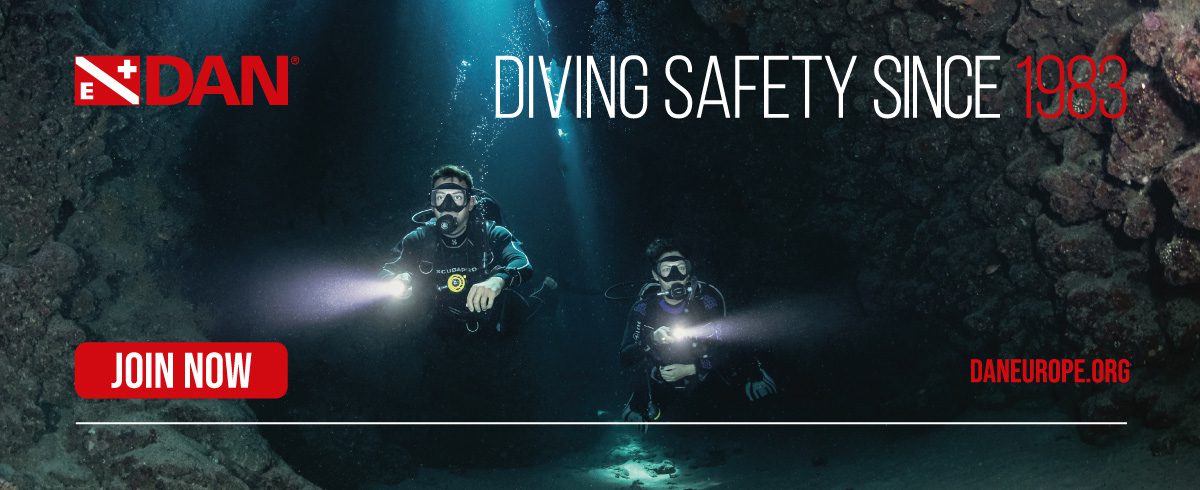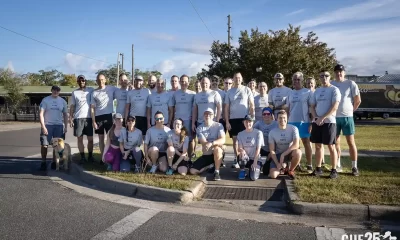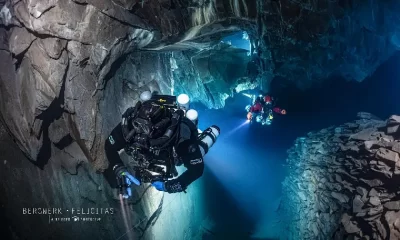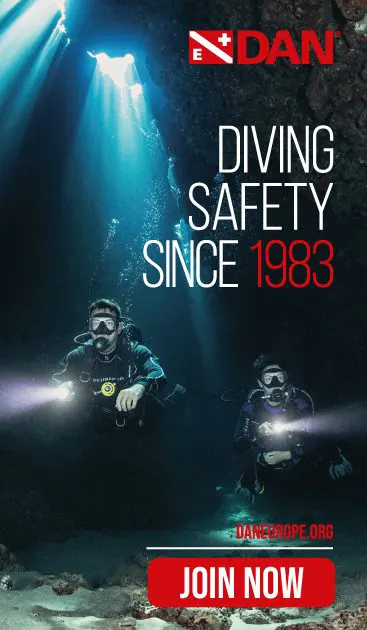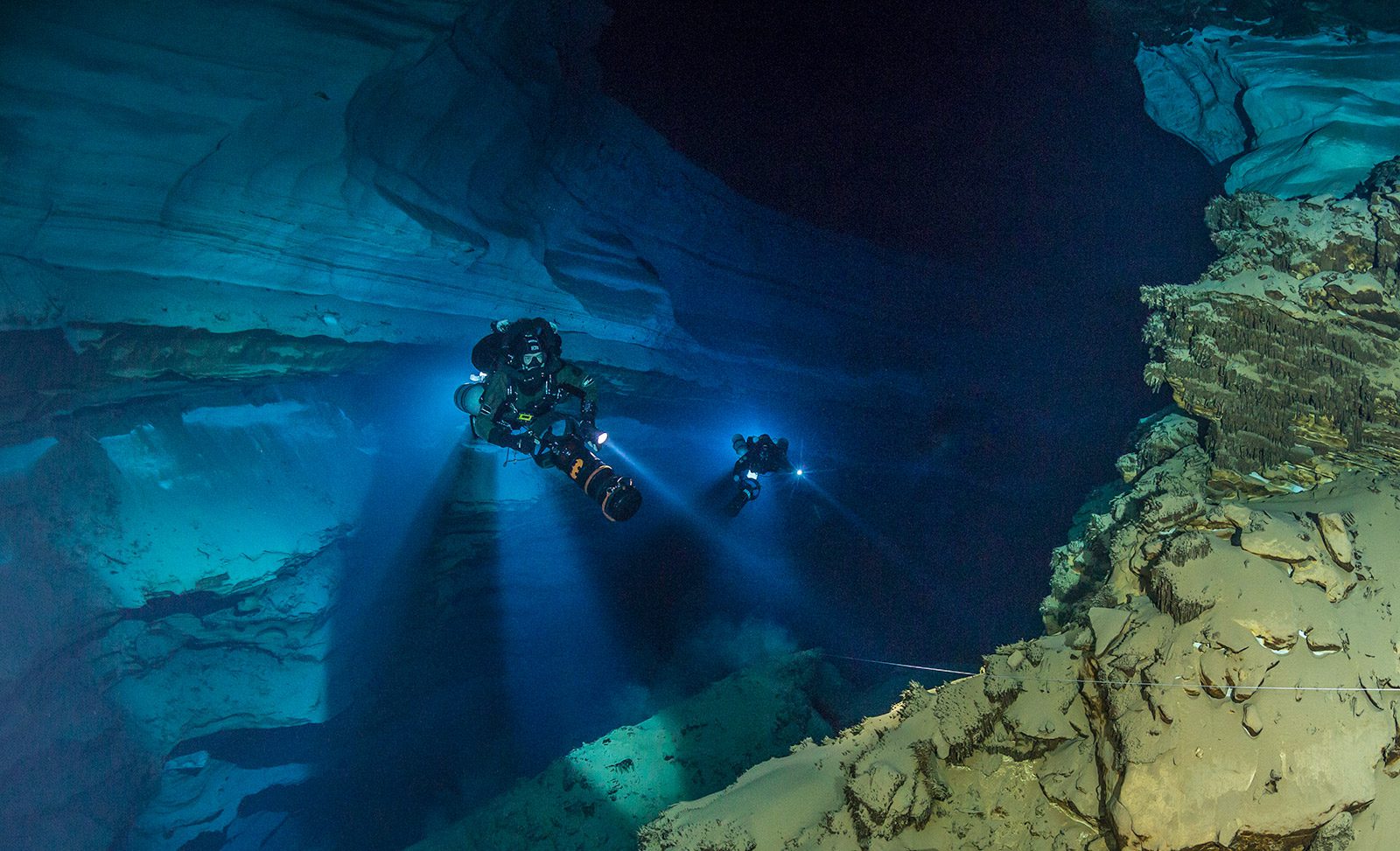
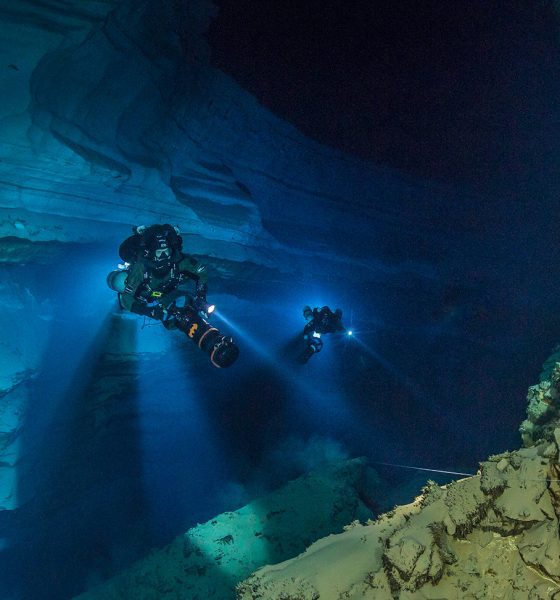
Diving Safety
When Easy Doesn’t Do It: Dual Rebreathers in Extended-Range Cave Diving
Rebreather technology has enabled cave explorers to extend their underwater envelope significantly deeper and longer. As a result, a few teams are pushing beyond the practical limits of open circuit bailout and so have turned to bailout rebreathers. But these are not without challenges, as Tim Blömeke, who dives into the latest research and field experience, explains.
by Tim Blömeke. Lead image: KUR divers Bob Beckner and Derek Ferguson in the 124m/407 ft deep Mount Doom chamber in Weeki Wachee Spring, Florida, courtesy of Kirill Egorov.
Dual rebreathers are becoming a thing among the elite of extended-range cave diving. Yet the “Blueprint for Survival” for this type of equipment configuration has yet to be written, and practitioners are faced with difficult trade-offs between competing design goals—like fitness for purpose, logistical feasibility, simplicity, reliability, and ease of use, all of which interact with the peculiarities of human nature. A new research paper proposes a pathway for risk assessment.
The introduction of rebreathers has considerably extended the range of exploration in cave diving. This is true especially for deeper dives, where open circuit technology faces the combined challenges of greater required gas volumes and higher required helium content, which make such dives both difficult to execute logistically due to the sheer number of cylinders involved, and prohibitively expensive due to the amount of helium in each of these cylinders.
By conserving the metabolically inert components of the breathing gas (most notably the helium), the use of closed circuit rebreathers (CCR) eliminates a good chunk of this problem, but not all of it: Traditional CCR diving procedures require that each diver have enough open-circuit bailout gas available to safely end the dive in the event of a rebreather failure.
Granted, the amount of bailout gas required for a CCR dive is only a fraction of what would be needed to perform the same dive on open circuit, and if all goes well, the bailout gas will never be breathed by anyone and can be reused for future dives. However, bleeding-edge explorers being who they are and doing what they do, after having used their CCRs to push the range of operations a few miles deeper into the cave systems, they began to encounter an issue very similar to the one that prompted the switch to CCR in the first place: cost and logistics.
As a real-world example, bailing out from a long-distance cave penetration of 7,500 meters at an average diver propulsion vehicle (DPV) travel speed of 40 m/min takes 187 minutes. Assuming a mean ambient pressure of 6 ATA (50 m depth) and a respiratory minute volume (RMV) of 14 l/min, the amount of bailout gas (not including decompression) required to reach the entrance would be 15,708 liters, or more than seven AL80 cylinders filled to 200 bar. This RMV is likely not conservative enough, given the extreme distance and the possibility of a hypercapnic event being the cause of the bailout so, in practice, a safety margin of at about 50% would be added, giving a total of 10-11 AL80 bailout cylinders.
The required amount of bailout gas became too large to be carried on the person of the diver, so that cylinders again needed to be staged in a series of set-up dives. Preparations for extended range exploration dives became ever more involved, and logistics became just as difficult to manage as those of old-school open circuit dives–even more so, arguably, due to the considerably greater distance of the staging points from the cave exit. As happens so often, overcoming one obstacle resulted in the discovery of others further down the road.

New safety concerns started to appear as well: For large-scale exploration projects, bailout cylinders needed to remain in a cave system for months at a time, sustaining severe corrosion damage at the tank neck and tank valve interface in the process due to the galvanic reaction between the chrome-plated brass valve and the aluminum cylinder. This isn’t merely a hypothetical concern: On many occasions, the corrosion was so severe that the integrity of the seal was compromised, and explorers found their previously staged bailout cylinders empty when checking them on their way into the cave. While this can be counteracted by installing a magnesium anode on the cylinder (magnesium is lower in the Galvanic series than aluminum and replaces the latter in the reaction), explorers found that the countermeasure only mitigates the issue but does not eliminate it. Long story short, for extreme extended-range dives, open circuit bailout was becoming ever more impractical and problematic.
Enter The Bailout Rebreather
As a solution to these problems, some explorers began to do away with open circuit bailout altogether and carry a redundant rebreather system—a closed circuit rebreather, or a semi-closed rebreather (SCR) instead. While this practice has gained significant traction recently, the concept itself isn’t new. In his book The Darkness Beckons, famed Welsh explorer Martyn Farr reports that his German colleague, pioneering cave diver Jochen Hasenmayer, had experimented with a dual unit he dubbed the Speleo-Twin Rebreather (STR-80) as early as 1981.

In 1987, Dr. Bill Stone delivered a proof of concept by spending 24 hours underwater on a dual CCR, he dubbed “Failsafe Rebreather for Exploration Diving” (FRED), during his visionary Wakulla Springs Project 1987. However, it appears that the first person to utilize redundant rebreathers in actual exploration was Olivier Isler from Switzerland. On August 12, 1990, he first used a triple RI2000 semi-closed unit in his crossing of the Emergence du Ressel (Doux de Coly, France), covering a distance of 1850 m/6070 ft at a maximum depth of 81 m/266 ft. The following year, Isler went on to push through the 4000 m/2.5 mi penetration barrier for the first time. More than a decade later, in 2002, Reinhard Buchaly and Michael Waldbrenner pushed the exploration of the Doux de Coly farther using dual RB80s, which were originally designed by Buchaly and continue to be produced to this day by Halcyon.

The decision to replace open-circuit bailout with a rebreather is as obvious as it is bold: Obvious because it replicates the successful solution to a past problem and restores the ability of a diver to carry all the gas they need on their person. Bold because… well. Put yourself in the drysuit boots of a cave diver, hours and hours away from the surface, who just survived an assassination attempt by a complex piece of life support equipment. All technical aspects aside, wouldn’t it be reassuring to fall back on a less complex piece of life support equipment whose proper functioning can be ascertained reliably within a few seconds?

Expressed in numbers, a paper by Andrew Fock, Analysis of recreational closed-circuit rebreather deaths 1998-2010, published in 2013, analyzed dive accident statistics for the period from 1998 to 2010 and found that CCR diving is associated with an increase in the risk of death by a factor of up to ten compared with open circuit diving. That ratio essentially applied to CCR dives, which used open circuit bailout. Rebreather technology and diving practices certainly have improved since the time under investigation, but the fact still remains that the complexity of the equipment adds to the overall risk.
With this in mind, taking a closer look at and trying to define the specific risks and benefits of replacing open-circuit bailout with a redundant SCR or CCR seems a reasonable idea. And this is precisely what a team of authors headed by Derek B. Covington did in a recent (March 2022) research paper, asking the question, “Is more complex safer in the case of bailout rebreathers for extended range cave diving?”
Using a qualitative approach, the authors discuss the reasoning behind bailout rebreather use, its history, different configurations and the various advantages and disadvantages and, finally, the additional potential for human error created by increasing the complexity of the equipment.

Bailout SCR vs. Dual CCRs
In terms of configurations, there are two main choices for a bailout rebreather: SCR or CCR. With an SCR, the diver still has to carry bailout gas. However, an SCR (such as the side-mounted Halcyon RBK) extends the use of this gas by a factor somewhere between four and ten, thereby drastically reducing the number of cylinders needed while being only the size of a single AL80 cylinder itself. Other advantages of a bailout SCR are that its relative simplicity and lack of sensors or other electronics make it much easier to set up, maintain, and use than a secondary CCR.
These advantages, however, do not come without downsides. With an SCR, the diver does not have the option of adding oxygen into the loop, and the actual oxygen content of the gas breathed is always somewhat lower than the oxygen content of the gas in the cylinders carried. How much lower exactly depends on the portion of the gas vented into the water on each operating cycle of the unit—or the rate of fresh gas supply into the unit—as well as the metabolic needs of the diver.
Therein lies the crux: For normal operation, the amount of oxygen consumed by the diver, and thus the resulting effective composition of the breathing gas, can be calculated quite reliably. In a bailout scenario, however, it isn’t unlikely for the metabolic needs of the diver to be increased due to higher workload. Without sensors to measure PO2, the precise composition of the breathing gas in the SCR loop becomes unknown, creating a risk of hypoxia, with all the potential consequences that come with it. This risk is unique to SCRs and not present when diving open circuit (where the cylinder sticker tells us what we’re breathing) or while on a CCR (where sensors tell us what we’re breathing).
The other approach is to go for a redundant CCR, as Stone envisioned back in 1987. While seemingly the “purest” in concept—replacing like with like—and optimizing redundancy, the added complexity is significant. Everybody who owns a CCR (especially an eCCR) knows that these machines need lots of love to remain in good working condition. Now multiply that by two: twice the number of sensors, two scrubbers, two sets of primary electronics, two sets of secondary electronics … and that’s just out of the water.

To have the redundant system available to them at all times during the dive, divers now need to manage the contents of two breathing loops instead of one. Furthermore, in order to be able to provide assistance in the event of a problem, divers working in a team need to be aware of the failure modes of and emergency procedures for not only their own units, but also the units used by their teammates. Unless everybody on the team is using the same machines for primary and bailout, this considerably adds to the training requirements, as well as to the complexity of the decision-making tree in an emergency situation. Nevertheless, by maximally reducing the required amount of gas to be carried by each diver, a redundant CCR theoretically provides the greatest degree of independence and offers the greatest potential range of exploration.
Approaches to Risk Assessment
To date, the use of dual rebreathers is still too rare for a quantitative, empirical assessment of its safety to be practical, and there is no systematic process in place for collecting data on dual-rebreather dives. “It’s really almost impossible to put a number on it,” said researcher and explorer Andy Pitkin, who co-authored the study. “I think there are only a small number of divers in the world who really need a bailout rebreather, but there are probably quite a few who use them because the idea appeals to them more than using OC bailout. Of course, there is no hard dividing line between the two groups. Where does logistical difficulty become impossible? That’s a very subjective judgment.”
The diversity of configurations and procedures used is another obstacle to objective study. “Are we using identical primary and bailout rebreathers, or is one unit specifically designed as a backup? If the latter, should the bailout unit be another CCR or an SCR? If the former, what are the diving procedures? Does the diver switch between loops at regular intervals, analogous to the procedures for independent doubles or sidemount diving? This would arguably add to task loading. Do the units have separate DSVs or a single, shared one, like that used by Richard Harris and Craig Challen of the Wet Mules? If the diver doesn’t alternate between units, then what other procedures are in place to ensure that both loops remain breathable at all times, especially during depth changes? If using dual CCRs, then what is the approach to ensuring redundancy of the diluent and oxygen supplies?”

The number of open questions and the range of possible, viable answers seem endless. Similar to the situation in the early days of cave diving, the book on bailout rebreathers has yet to be written. While many of the timeless principles from Sheck Exley’s famous booklet, Basic Cave Diving: A Blueprint for Survival continue to apply accordingly, there is no broad consensus yet on best practices, no SOP Manual, no standardized configuration, no published training standards for dual rebreather diving by any training agency. People are still working things out for themselves or their teams.
In consideration of these difficulties, and as a starting point for a discussion, the authors of Is more complex safer… propose a generalized approach to assessing the risks of dual-rebreather diving. Rather than delving into the minutiae of the failure modes of each individual diver’s equipment setup and diving procedures, they outline a method for identifying potential error-producing conditions (i.e., opportunities for human operators to make mistakes) based on a theoretical model originating in risk assessment for nuclear power plants: the WITH/TWIN model (Table 1). The acronym WITH stands for Workplace Design, Individual Capabilities, Task Design, Human Nature. TWIN refers to the same items (Task, Workplace, Individual, Nature).

The underlying idea of this approach is to move beyond merely looking at “human error” prima facie—oh, the diver failed to pack his scrubber properly? How could they! They neglected to monitor their PO2? Pay more attention!—and instead, analyze the conditions that are conducive to such errors. For the purposes of the model, a diver’s equipment configuration is part of their Workplace, their training and fitness belong in Individual Capabilities, the mission, including not only managing one’s gear but also navigation, linework, photography/videography, and surveying fall under Task.
All these aspects interact with Human Nature. We get stressed when things get exciting, we get complacent when things go smoothly. We are prone to false assumptions, we are terrible at intuitive probability assessment, and our ability to pay attention falls off rapidly once the number of items that need our attention increases significantly beyond the number of voices in our heads. Much like running a nuclear power plant, excellence in cave diving isn’t achieved by sporadic strokes of genius but instead by consistently avoiding mistakes, and an important aspect of the design of equipment and procedures for either is to compensate for the inherent weaknesses of the human mind.
In the words of the study’s authors:
“Divers and explorers need to consider not just the technical aspects of operating the dual CCR as an equipment-based system, but also the socio-technical aspects and error-producing conditions that adding additional complicated equipment has to the wider system, especially when it comes to training for and executing abnormal operations when workout levels will be high and awareness will be reduced. Nonetheless, as the use of this configuration grows, the risks and benefits will become clearer to investigators and divers alike.”
It will be exciting to observe the future development of dual-rebreather diving as it matures and see where the consensus for best practices will end up… stay tuned and stay safe!
References:
Diving and Hyperbaric Medicine: Is more complex safer in the case of bail-out rebreathers for extended range cave diving? Derek B Covington, Charlotte Sadler, Anthony Bielawski, Gareth Lock, Andrew Pitkin
Fock AW. Analysis of recreational closed-circuit rebreather deaths 1998-2010. Diving Hyperb Med. 2013;43(2):78-85.
NSS-CDS (free download): Basic Cave Diving: A Blueprint for Survival by Sheck Exley
Dive Deeper
aquaCORPS N12: Designing a Redundant Life Support System by William C. Stone (1995)
InDEPTH: The RB80 Semi-closed Rebreather: A Successful Exploration Tool by David Rhea
Halcyon: Using The RB80 As A Side-mounted Bailout Rebreather by Andy Pitkin, Karst Underwater Research (2018)I
InDepth: Rebreather Holiday Shopping Guide (2020)
aquaCORPS Pioneer Interviews: Stoned: Interview With Dr. William Stone (1994) by Michael Menduno
InDEPTH: Diving Beyond 250 Meters: The Deepest Cave Dives Today Compared to the Nineties by Michael Menduno and Nuno Gomes
Deep Tech: Victory At Last (1998) by John Simenon: Olivier Isler is setting penetration records with a triple-redundant semi-closed rebreather

Tim Blömeke teaches technical and recreational diving in Taiwan and the Philippines. He is also a freelance writer and translator, as well as a member of the editorial team of Alert Diver. For questions, comments, and inquiries, you can contact him via his blog page or on Instagram.











